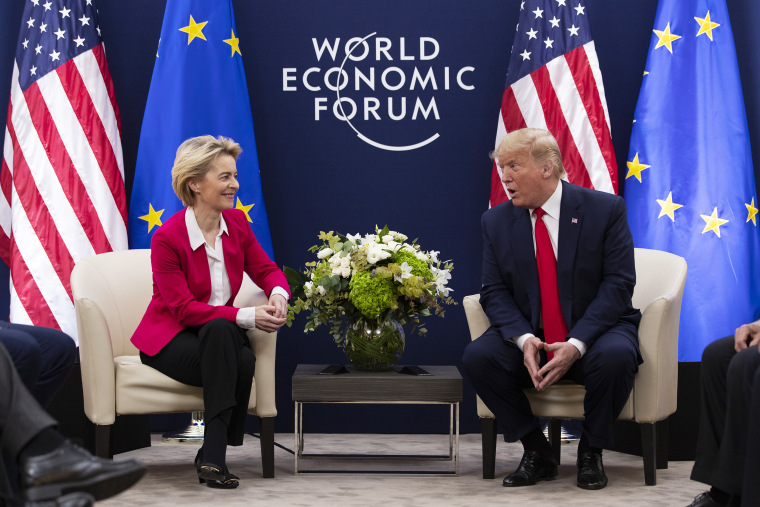The European Union has pushed back against President Donald Trump’s latest suggestion that he will impose a 50% import tariff on all E.U. goods, warning that trans-Atlantic trade must be built on “respect, not threats.”
The rebuke came after Trump said in a Friday post on his Truth Social platform that trade negotiations with Brussels were “going nowhere” and suggested he would slap a 50% blanket duty on all European goods entering the U.S. starting June 1.
It was just the latest bellicose remark from Trump and came amid a broader souring of relations between the two global powers that has seen months of distrust and economic sparring.
The E.U., home to nearly 450 million people, is the world’s largest trading bloc and one of Washington’s top commercial partners. It exported more than $600 billion in goods to the U.S. last year while importing goods worth around $370 billion.

Trump’s latest broadside follows his April 2 “Liberation Day” announcement of a 39% tariff on European goods, an idea he later walked back before he changed course again Friday with an even tougher stance.
Stephen Moore, a former economic adviser to Trump, told the BBC that his former boss was expressing his frustration with the E.U.
“I think he was hoping that by now we would have the E.U. coming with some kind of deal on the table, and so far that hasn’t come,” he said, calling the 50% import tariffs a “shot at the bow.”
E.U. Trade Commissioner Maroš Šefčovič said late Friday that “E.U.-U.S. trade is unmatched & must be guided by mutual respect, not threats,” and that the bloc remains committed to securing “a deal that works for both,” following a call with U.S. Trade Representative Jamieson Greer and Commerce Secretary Howard Lutnick.
While the E.U.’s response signals a willingness to negotiate, discord has deepened between the bloc and its longtime trans-Atlantic ally over a return to the combative stance Trump took during his first administration, when he flew in the face of decades of cooperation and cast the E.U. as an economic rival.
In 2018, Trump said “nobody treats us much worse than the European Union” and argued the bloc was designed to exploit the U.S. He repeated that claim this year, describing the E.U. as being “formed in order to screw the United States.”
While the ideological architects of Trump’s first administration such as Steve Bannon and Peter Navarro have also gone on record criticizing the union, many in Trump’s current inner circle have shared those sentiments.

Vice President J.D. Vance lashed out in February at European leaders at a security conference in Munich over issues ranging from free speech to migration and defense, dealing a sucker punch to the European view of America as a steadfast cultural ally.
“The threat that I worry the most about vis-à-vis Europe,” Vance said, “is the threat from within — the retreat of Europe from some of its most fundamental values, values shared with the United States of America.”
That came after Elon Musk — the world’s richest man, who also served as Trump’s close adviser earlier in his second term — threw his support behind Germany’s far-right Alternative for Germany party, which has called for Germany to leave the E.U.
Underlying much of the second Trump administration’s animosity toward Europe has been security funding, most prominently over the war in Ukraine.
While the administration’s view of the war in Ukraine has since softened, Vance has repeatedly opposed sending military aid to Kyiv, saying in February that “I don’t really care what happens to Ukraine one way or another.”
And in a Signal conversation between senior administration officials leaked in March, the vice president initially resisted U.S. strikes in Yemen, arguing he didn’t want to “bail Europe out,” while Defense Secretary Pete Hegseth warned that Europe was treating America like a “sucker” by relying on it for defense.
While Šefčovič’s call for a “deal that works for both” reflects the E.U.’s characteristically restrained response to the Trump administration’s jabs, Europe has been bracing itself for months for the possibility of a more distant economic relationship with the U.S. too.

Earlier this month, Šefčovič said the bloc preferred to negotiate, “but not at any cost,” before announcing more than $100 billion worth of possible retaliatory tariffs on U.S. goods the following day.
Europe also appears to be preparing for a future without America’s guarantee of European security against Russia. Germany this week deployed a permanent military brigade beyond its borders for the first time since the end of World War II.
A brewing trade war with the bloc throws into relief the position of Britain, which voted to leave the E.U. in 2016, but recently signed a trade deal with Europe and an economic deal with the U.S.
London appears to have sidestepped the steepest tariffs after Trump agreed last month to hold the levy on British goods at 10%, but the U.K. must now walk a delicate line: maintaining its “special relationship” with Washington while seeking closer alignment with its largest trading partner in Brussels.
But with tensions rising across the Atlantic, even allies risk being caught in the crossfire. The E.U. — a geopolitical heavyweight in its own right — is unlikely to take hefty U.S. tariffs lying down without making moves of its own.








Recent Comments